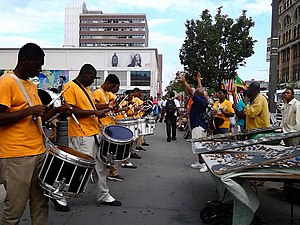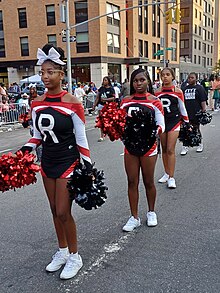This article needs additional citations for verification. (August 2022) |
| Total population | |
|---|---|
| 1.996 million[1] (2020) | |
| Regions with significant populations | |
| Central Harlem, the North Bronx, Central Brooklyn, and southeast Queens[2] | |
| Languages | |
| African American Vernacular English, New York City English, American English, Caribbean English, Jamaican Patois,[3] New York Latino English, Spanish, Dominican Spanish, Cuban Spanish, Puerto Rican Spanish, African languages | |
| Religion | |
| Christianity (Mainly Historically Black Protestant and Catholicism), Judaism, Islam, irreligious,[4] Rastafari | |
| Related ethnic groups | |
| Caribbeans in New York City especially Jamaican Americans in the city, Black Jews in New York City, Puerto Ricans in New York City, Dominicans in New York City, African immigration to the United States |
| Part of a series on |
| Race and ethnicity in New York City |
|---|
| Part of a series on |
| African Americans |
|---|


African Americans constitute one of the longer-running ethnic presences in New York City, home to the largest urban African American population, and the world's largest Black population of any city outside Africa, by a significant margin.[6] As of the 2010 census, the number of African Americans residing in New York City was over 2 million.[7] The highest concentration of African Americans are in Brooklyn, Harlem, Queens, and The Bronx.[7] New York City is also home to the highest number of immigrants from the Caribbean.[8]
Since the earlier part of the 19th century, there has been a large presence of African Americans in New York City.[9] Early Black communities were created after the state's final abolition of slavery in 1827.[10] The metropolis quickly became home to one of the most sizeable populations of emancipated African Americans.[11] But Blacks did not receive equal voting rights in New York until the ratification of the Fifteenth Amendment of the Constitution in 1870.[12] New York City and other northern cities saw a sharp rise in their Black populations in the wake of Jim Crow in the South.[13] In the early 1900s, many African Americans moved to Harlem, due to a number of factors, including many Black migrants relocating from the South to the North.[14] But the demographic shift would change once again in the 20th century. In 1936, overcrowding in Harlem caused scores of African Americans to leave and move to Bedford-Stuyvesant, which eventually became the second largest Black community in New York City.[15]
New York City's Black population would be altered again in the 21st century. Between 2000 and 2020, many Black families left the city primarily due to the city's high cost of living.[16] Many blacks leaving New York City have moved to cities in the U.S. South, including Atlanta, Charlotte, Dallas, Houston, Jacksonville, Little Rock, Memphis, Orlando, New Orleans, Charleston, Portsmouth, Oklahoma City, West Palm Beach, Missouri City, Peachtree Corners, Tampa, Austin, Sugar Land, Gaithersburg, Wilmington, Durham, Greensboro, Fayetteville, Jackson, Killeen, Birmingham, Huntsville, Nashville, Arlington, Columbia, Raleigh, Richmond, Fort Worth, Greenville, and San Antonio.[16] In the wake of the COVID-19 pandemic, the number of African Americans in New York City declined, due to Blacks having a higher rate of contracting and dying from the virus than other racial groups.[17]
- ^ "New York City - Place Explorer - Data Commons". datacommons.org. Archived from the original on September 18, 2024. Retrieved December 9, 2023.
- ^ "Where New Yorkers Live". Where We Live NYC. Archived from the original on June 29, 2022. Retrieved December 9, 2023.
- ^ Bloomquist, Jennifer; Green, Lisa J.; Lanehart, Sonja L.; Blake, Renée A.; Shousterman, Cara; Newlin-Lukowicz, Luiza (2015). "African American Language in New York City". The Oxford Handbook of African American Language. doi:10.1093/oxfordhb/9780199795390.013.37. ISBN 978-0-19-979539-0. Archived from the original on May 8, 2021. Retrieved May 25, 2022.
- ^ "Religious Landscape Study". Archived from the original on May 25, 2022. Retrieved May 25, 2022.
- ^ Cite error: The named reference
AfricanMigrationNYCwas invoked but never defined (see the help page). - ^ Tamir, Christine (March 25, 2021). "The Growing Diversity of Black America". Pew Research Center. Archived from the original on July 24, 2022. Retrieved April 8, 2023.
- ^ a b "NYC 2010: Results from the 2010 Census" (PDF). NYC.Gov. Archived (PDF) from the original on July 4, 2023. Retrieved July 4, 2023.
- ^ Kasinitz, Philip (1992). Caribbean New York: Black Immigrants and the Politics of Race. Ithaca, NY: Cornell University Press. ISBN 9780801426513.
- ^ Peterson, Carla (February 17, 2012). "Answers About Black Life in 19th-Century New York, Part 2". The New York Times. Archived from the original on July 4, 2023. Retrieved July 4, 2023.
- ^ Landy, Craig (June 7, 2017). "When did slavery end in New York?". Historical Society of the New York Courts. Archived from the original on July 4, 2023. Retrieved July 4, 2023.
- ^ "The African Americans: Many Rivers to Cross". PBS. Archived from the original on July 24, 2019. Retrieved July 4, 2023.
- ^ Landy, Craig (June 7, 2017). "When Did Slavery End in New York?". Historical Society of the New York Courts. Archived from the original on July 4, 2023. Retrieved July 4, 2023.
- ^ "The Great Migration (1910-1970)". The National Archives and Records Administration. May 20, 2021. Archived from the original on September 27, 2022. Retrieved July 4, 2023.
- ^ "Great Migration". History.com. January 11, 2023. Archived from the original on February 28, 2021. Retrieved July 5, 2023.
- ^ Dubose-Simons, Carla (January 2013). "The "Silent Arrival": The Second Wave of the Great Migration and Its Effects on Black New York, 1940-1950". CUNY Academic Works. Archived from the original on July 6, 2023. Retrieved July 5, 2023.
- ^ a b Cite error: The named reference
Gothamistwas invoked but never defined (see the help page). - ^ Ray, Rashawn (April 9, 2020). "Why Are Blacks Dying At Higher Rates From COVID-19?". The Brookings Institution. Archived from the original on July 6, 2023. Retrieved July 5, 2023.
